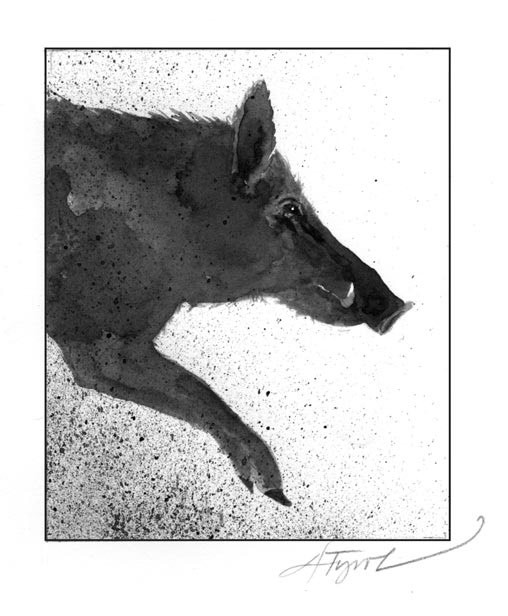
Ever wonder why those Angry Birds on your smartphone app are so mad at those pigs? It’s probably because the pigs are feral.
According to estimates by the U.S. Department of Agriculture (USDA), there are about five million free-ranging, feral swine living in the U.S. and they’re wreaking havoc on native ecosystems. If you were a ball-shaped bird, all that destruction might be enough to make you want to launch yourself at the swine with a slingshot.
Feral swine come from two sources: pigs escaped from farms and European wild boars escaped from hunting preserves. Since they are escaped captive species and not native here, they’re called “feral,” not wild.
On the lam, even the farm piggies quickly revert to something tusked and hairy. The young are known as stripers, for their striped tan, white, and black fur. These pigs are more Pumbaa than Porky.
Feral swine are rooting up golf courses and farm fields throughout the American South. They’ve overturned tombstones in a state cemetery in Oklahoma. They gobble up the eggs of turtles and ground-nesting birds. They chow down on salamanders and even the occasional deer fawn. And because they are not native to this continent, they have no natural predators here.
The swine are predominantly a southern problem, buy they’re moving north. In 1982, there were established feral pig populations in 17 states; today, they’re found in 38. There are few hundred of them in New Hampshire. Vermont has the occasional feral oinker – one caused an accident on I-91 in 2010 – but so far, they are not known to breed there.
The feral swine in our area have been here for a while. “I’ve been here for 18 years, and feral swine have been here for all that time, and even before,” says Mark Ellingwood, wildlife supervisor with the New Hampshire Fish and Game Department.
Most of the feral swine in New Hampshire are found in Grafton, Sullivan, and Cheshire counties. A large game preserve in the area is a suspected source, although Ellingwood reports that the feral swine are now breeding outside of the preserve’s fence, which means that the population is now increasing by the litter (three to 13 piglets), instead of by the occasional adult escapee
“We’ve had animals as far north as Littleton, and in southern New Hampshire as well,” says Ellingwood. “It’s a stretch to claim we know the source of all these animals.”
“Years ago I used to think that the climate would preclude them from surviving in the wild here,” says Scott Darling, wildlife management program director for the Vermont Fish and Wildlife Department. But recently, he notes, breeding feral swine were reported in upstate New York. There are populations in other northern states and in Canada.
Darling says Vermont is vulnerable both to feral swine crossing from New Hampshire, and from the state’s own game preserves, some of which stock wild European boar.
Parker Hall, the state director for New Hampshire and Vermont for the USDA’s Animal and Plant Inspection Service (APHIS), says there is no reason to wait around to see what damage feral swine will do in New Hampshire. They already have a record of destroying cornfields and rooting up people’s backyards.
While his voice drips of Tupelo honey (his previous posting included Alabama and Georgia), his message is pure Dirty Harry: “We know they are bad,” Hall says. “The damage that they do has been documented for years.” The solution, he suggests, is to trap and kill them.
Hall says the state listed Blanding’s turtles, marble salamanders, and spotted turtles are in the feral swine’s crosshairs. Without quick action, Hall explains, the feral swine may eat the last of these vulnerable creatures in the state.
Luckily, he says, years of experience in other parts of the country can be applied to feral swine in the Northeast. Creating a hunting season for them is one idea. However, Hall says hunters can only reduce feral swine populations by 20 percent – too few to make an impact on the population.
The trick, he says, is to trap them in a fenced enclosure using sour corn as bait. The trapping is done in the winter, when the feral swine aren’t chowing down on their very favorite food, acorns.
Who knows, he might be able to teach those angry birds a thing or two.


Discussion *